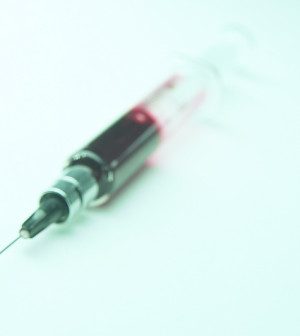- Skip Storing This Everyday Product in the Fridge Door
- Green Tea + B3 Pairing May Boost Brain Health
- Navigating Your Midlife Crisis: Embracing New Possibilities
- City Raccoons Showing Signs of Domestication
- Mapping the Exposome: Science Broadens Focus to Environmental Disease Triggers
- One Week Less on Social Media Linked to Better Mental Health
- Your Brain Changes in Stages as You Age, Study Finds
- Some Suicide Victims Show No Typical Warning Signs, Study Finds
- ByHeart Formula Faces Lawsuits After Babies Sickened With Botulism
- Switch to Vegan Diet Could Cut Your Greenhouse Gas Emissions in Half
Major Women’s Health Study Paid Big Dividends


A comprehensive look at the decade-old “estrogen study” — the U.S. government-sponsored trial that turned the tables on assumptions about hormone replacement therapy — suggests there can be a billion-dollar upside to the millions spent on research.
The research, published May 6 in the Annals of Internal Medicine, shows the public has received a high return on its tax-funded investment in the Women’s Health Initiative (WHI).
“Everything we do in medicine comes with a level of uncertainty,” said Dr. Scott Ramsey, the study’s lead author and director of the Hutchinson Institute for Cancer Outcomes Research, in Seattle. “The question is whether it’s worth the investment in research to be sure we’re not making a mistake.”
The results of his research, he said, showed that, even though the WHI cost $260 million, the net economic return was $37 billion, or $140 for every dollar spent on the trial.
“Even if we only focus on medical care costs, the study saved $27 billion, a huge savings and, I think, quite a conservative estimate because we didn’t assume all the decline in hormone replacement therapy was due to the study,” said Ramsey.
Before the WHI study, almost 6 million menopausal American women took a pill called combined hormone therapy, which paired the hormones estrogen and progestin, to reduce hot flashes and cut their risk of cardiovascular disease and the bone-thinning disease osteoporosis.
But the WHI’s Estrogen Plus Progestin clinical trial, a huge, randomized and controlled trial, which is considered the gold standard for research, produced shocking results. Rather than cutting the risk of serious disease, combined hormone-replacement therapy (HRT) actually increased the chances women would develop cardiovascular disease, blood clots and breast cancer, according to the evidence produced by the study. The trial was stopped in 2002, after investigators found that the associated risks of HRT outweighed the benefits.
As a result of the $260 million research, funded by the U.S. National Institutes of Health, many physicians stopped prescribing combined hormone therapy. Hormone use among menopausal women decreased almost immediately by about 50 percent and continued to decline by 5 percent to 10 percent each year, according to the researchers.
In the years following the drastic drop in hormone use, the number of cases of breast cancer, cardiovascular disease and blood clots declined significantly.
The latest research shows that 10 years after the WHI study was widely disseminated, there were 126,000 fewer cases of breast cancer, 76,000 fewer cases of cardiovascular disease, and 80,000 fewer cases of blood clots (in larger veins or lungs) than there were before the drop in HRT use.
On the other hand, the study also shows that hormone therapy may have played a role in preventing bone problems and colon cancer: The researchers found that there were 263,000 more fractures associated with bone weakening and 15,000 more cases of colorectal cancer after HRT use decreased.
For the new study, the research team used a statistical “disease-simulation model” that looked at HRT use after the WHI study was published and compared that with the expected use of hormone replacement therapy had the study not been done (if physicians had continued prescribing the pills as they had been doing). They then analyzed cost and health issues.
To understand the impact of the study on health finance, they gathered all the costs of treatments, side effects and loss of life, and subtracted those numbers from the cost of the study itself. Data was gathered up to 2012.
Comprehensive studies like the WHI are necessary to fully understand the unintended consequences of some medications, procedures and surgeries, Ramsey noted.
“This is a classic example of the potential long-term impact of drugs. We’re lucky this study happened. There was controversy within the National Institutes of Health [the study’s funders]; some people were really opposed to it. There is a role for big science, big studies like this, when there are big questions,” he added.
Many people don’t think of research as an investment, or they consider it to be something like choosing a Silicon Valley start-up to support, said Dr. Michael Lauer, who wrote an editorial accompanying the research and is director of the division of cardiovascular sciences at the U.S. National Heart, Lung, and Blood Institute. But with limited federal funds, decisions about what to support can be a roll of the dice, he explained.
“Can we go too far demanding return on investment? Like any good investor, it’s important for us to develop a diverse portfolio,” Lauer said. “But this paper shows that investment has paid off very nicely.”
Despite the success of the WHI and the demand to fund complex studies, Lauer isn’t optimistic that $260 million trials will continue to be funded in today’s economic climate. His hope is that advances in technology will make it easier to do large-scale clinical trials at lower cost, perhaps tapping vast amounts of Medicare data, he suggested.
Lauer said the study also taught medicine and science a lesson. “The study reminds us of the need to show humility when approaching scientific questions, and the need to do things right and rigorously.”
More information
Learn more about hormone replacement therapy from the U.S. National Library of Medicine.
Source: HealthDay
Copyright © 2025 HealthDay. All rights reserved.










